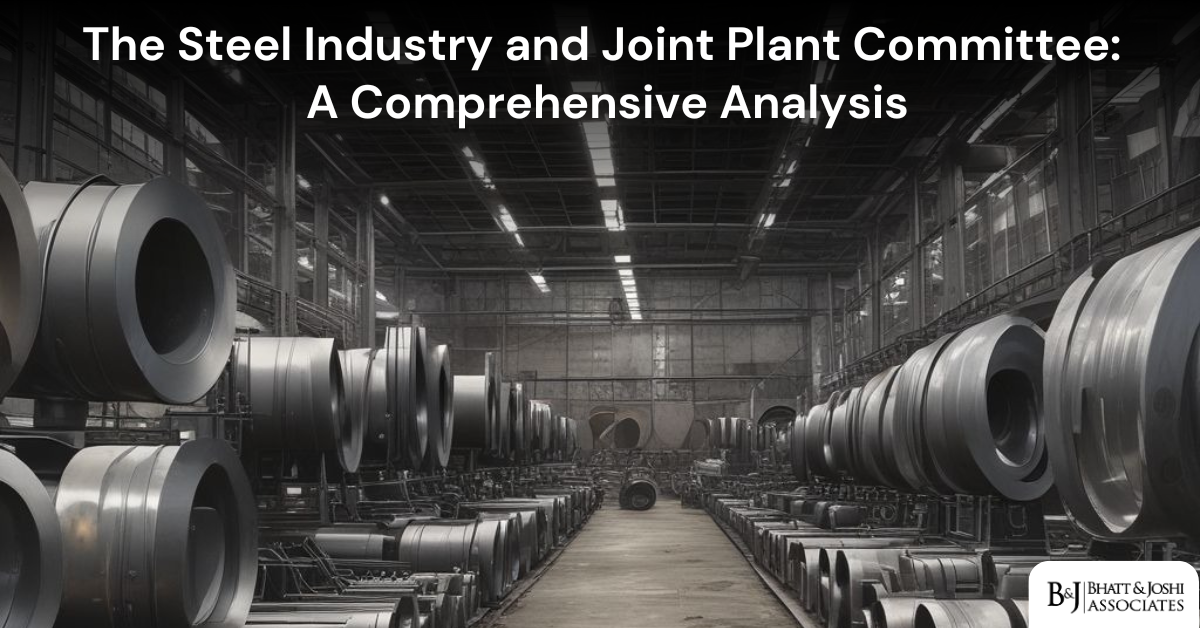Introduction
The Indian steel industry stands as a cornerstone of the nation’s industrial development, representing both its manufacturing prowess and economic potential. At the heart of this vital sector lies the Joint Plant Committee (JPC), a unique institution operating under the Ministry of Steel, Government of India. This comprehensive analysis explores the multifaceted role of the JPC in shaping and monitoring India’s steel sector, while examining its contribution to the industry’s growth and development through various initiatives and regulatory frameworks.
Historical Background of the Steel Industry in India
The evolution of India’s steel industry is deeply intertwined with the country’s industrial development journey. Following independence in 1947, the steel sector was identified as a critical driver of economic growth. The first Five Year Plan (1951-56) laid significant emphasis on steel production, leading to the establishment of major public sector steel plants. The formation of Hindustan Steel Limited (now SAIL) in 1954 marked a crucial milestone in India’s steel industry development. During this period, the need for coordinated development and monitoring of the steel sector became increasingly apparent, eventually leading to the establishment of the Joint Plant Committee.
The Steel Industry (Development and Regulation) Act of 1956 provided the legal foundation for governmental oversight of the steel sector. This act empowered the government to take necessary steps for the development of the iron and steel industry under a planned economy. The period between 1960 and 1980 saw the establishment of several integrated steel plants, and with this expansion came the need for a specialized body to coordinate and monitor the industry’s growth.
Joint Plant Committee (JPC): Formation and Evolution
The Joint Plant Committee was established in 1964 as an institution under the Ministry of Steel and Mines (now Ministry of Steel). Its formation was driven by the need for coordinated development of the iron and steel industry and the requirement for a specialized body to collect and analyze data related to the sector. The JPC was conceptualized as a unique institution that would bring together various stakeholders in the steel industry, including public sector undertakings, private sector players, and government representatives.
Initially, the JPC’s primary focus was on coordinating the activities of the main steel plants and ensuring optimal capacity utilization. Over time, its role expanded to encompass market monitoring, data collection, technical assistance, and policy advisory functions. The evolution of the JPC mirrors the transformation of India’s steel industry from a strictly regulated sector to a more market-oriented one following the economic liberalization of 1991.
Organizational Structure and Key Functions of the Joint Plant Committee
The Joint Plant Committee operates under a well-defined organizational structure that enables it to fulfill its diverse responsibilities effectively. The committee is headed by a Chairman, typically a senior official from the Ministry of Steel, and includes representatives from major steel producers, both public and private sector, as well as technical experts and government officials.
The core functions of the JPC can be categorized into several key areas. First, it serves as the central statistical organization for the iron and steel industry, collecting and compiling data on production, consumption, trade, and prices. Second, it provides technical and consultancy services to the industry, particularly to small and medium enterprises. Third, it conducts market research and analysis to support policy formulation and industry development.
The committee operates through various specialized divisions, each focusing on specific aspects of the steel industry. These include the Technical Division, Market Research Division, Statistics Division, and Information Technology Division. This structure enables the JPC to maintain a comprehensive overview of the industry while providing specialized support in different areas.
Data Management and Market Intelligence in the Steel Sector
One of the JPC’s most crucial functions is its role as the primary data collection and dissemination agency for the Indian steel industry. The committee maintains an extensive database covering all aspects of steel production, consumption, and trade. This includes detailed information about production capacities, actual production figures, inventory levels, prices, and international trade data.
The JPC employs a sophisticated data collection methodology that ensures accuracy and reliability. It maintains regular contact with steel producers, consumers, and traders across the country. The committee publishes various reports and bulletins, including the monthly “JPC Bulletin” and annual statistics, which serve as authoritative sources of information for industry stakeholders, policymakers, and researchers.
The market intelligence function of the JPC extends beyond mere data collection. The committee analyzes market trends, forecasts demand and supply scenarios, and provides insights into price movements. This information is crucial for both industry planning and policy formulation. The JPC’s market intelligence reports are widely used by the industry for business planning and investment decisions.
Joint Plant Committee Role in Policy Making
The Joint Plant Committee plays a vital advisory role in policy formulation for the steel sector. Its comprehensive database and analytical capabilities make it an invaluable resource for the Ministry of Steel in formulating policies and strategies for the industry’s development. The committee regularly provides inputs for various government initiatives, including the National Steel Policy and foreign trade policies affecting the steel sector.
The JPC’s policy advisory role is particularly significant in areas such as capacity planning, technology upgradation, and environmental compliance. The committee conducts detailed studies on specific policy issues and provides recommendations based on its analysis of industry data and market conditions. It also assists in formulating standards and guidelines for the industry in collaboration with other regulatory bodies.
Technical Support and Research
The technical support function of the JPC is crucial for the development of the steel industry, particularly for smaller players who may not have access to advanced technical expertise. The committee provides technical consultancy services, conducts training programs, and facilitates technology transfer. It also maintains a technical library and documentation center that serves as a valuable resource for the industry.
Research and development initiatives supported by the JPC focus on improving production efficiency, quality enhancement, and environmental protection. The committee collaborates with research institutions and industry bodies to promote innovation in the steel sector. It also organizes technical seminars and workshops to disseminate knowledge about new technologies and best practices.
Market Development Initiatives
The JPC actively participates in market development initiatives aimed at promoting steel usage in various sectors of the economy. This includes conducting studies on potential applications of steel, organizing awareness programs, and facilitating interaction between producers and consumers. The committee pays special attention to promoting steel usage in rural areas and non-traditional sectors.
The market development role of the JPC has become increasingly important in recent years as India aims to increase its per capita steel consumption to match international standards. The committee works closely with industry associations and government agencies to identify and address barriers to steel consumption growth.
Regulatory Framework and Compliance
While the JPC is not primarily a regulatory body, it plays an important role in monitoring compliance with various regulations affecting the steel industry. This includes environmental regulations, quality standards, and trade-related compliance requirements. The committee works in coordination with other regulatory agencies to ensure effective implementation of various rules and guidelines.
The regulatory framework surrounding the steel industry has evolved significantly over the years, and the JPC has adapted its role accordingly. It helps industry players understand and comply with various regulations while providing feedback to policymakers about the practical implications of regulatory requirements.
International Collaboration and Partnerships
The JPC maintains active collaboration with international organizations and steel industry bodies from other countries. These partnerships facilitate knowledge exchange, technology transfer, and alignment with global best practices. The committee represents India in various international forums related to the steel industry and maintains regular dialogue with counterpart organizations in other major steel-producing countries.
International collaboration has become increasingly important as the global steel industry faces common challenges such as overcapacity, environmental concerns, and trade issues. The JPC’s international partnerships help the Indian steel industry stay connected with global developments and adapt to changing international market conditions.
Challenges and Future Directions for the Indian Steel Industry
The Joint Plant Committee faces several challenges in fulfilling its mandate in an evolving industry landscape. These include the need to upgrade its data collection and analysis capabilities to keep pace with technological advancement, addressing environmental concerns while promoting industry growth, and helping the industry adapt to changing market conditions and regulatory requirements.
Looking ahead, the JPC is expected to play an even more crucial role in supporting the Indian steel industry’s ambitious growth plans. The National Steel Policy 2017 sets a target of 300 million tonnes of steel capacity by 2030-31, and the JPC will be instrumental in monitoring progress towards this goal and providing necessary support for its achievement.
Conclusion: The Joint Plant Committee’s Impact on Steel Growth
The Joint Plant Committee has established itself as a vital institution in India’s steel sector, providing crucial support for the industry’s development through its various functions. Its role in data collection, market intelligence, technical support, and policy advisory services has contributed significantly to the growth and development of the Indian steel industry. As the industry continues to evolve and face new challenges, the JPC’s role remains crucial in ensuring sustainable and competitive growth of the sector.
The committee’s ability to adapt to changing industry needs while maintaining its core functions has been key to its continued relevance. As India’s steel industry moves towards greater sophistication and global integration, the JPC’s role in providing reliable data, technical support, and policy inputs will become even more critical. The institution stands as a unique example of successful industry-government collaboration, contributing significantly to the development of one of India’s most important industrial sectors.














